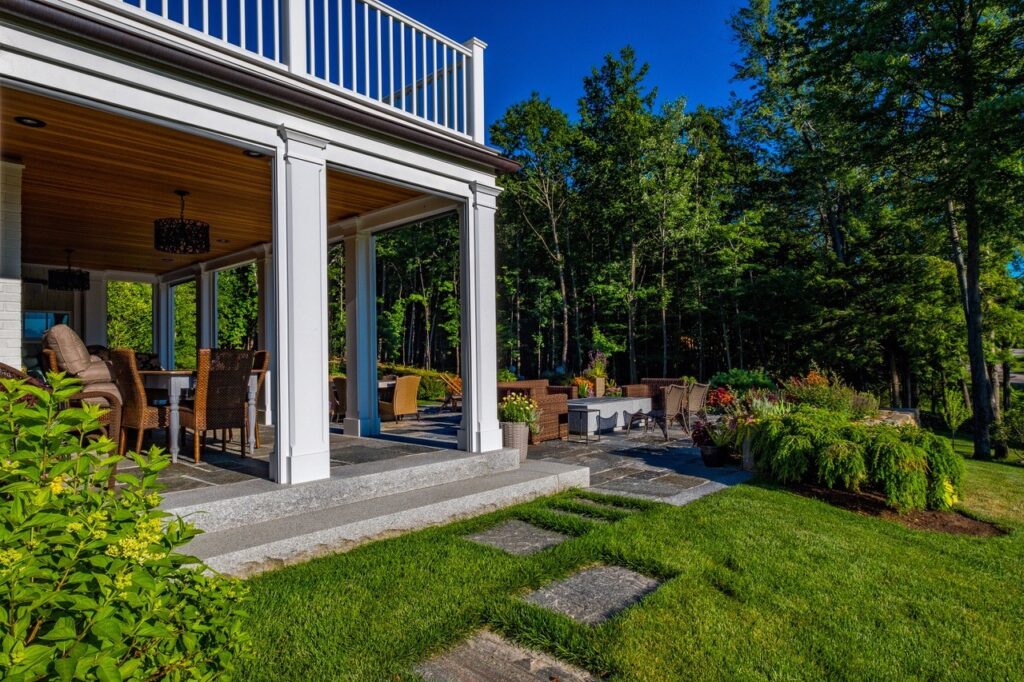Balancing Your New England Landscape Design with Hardscapes and Softscapes
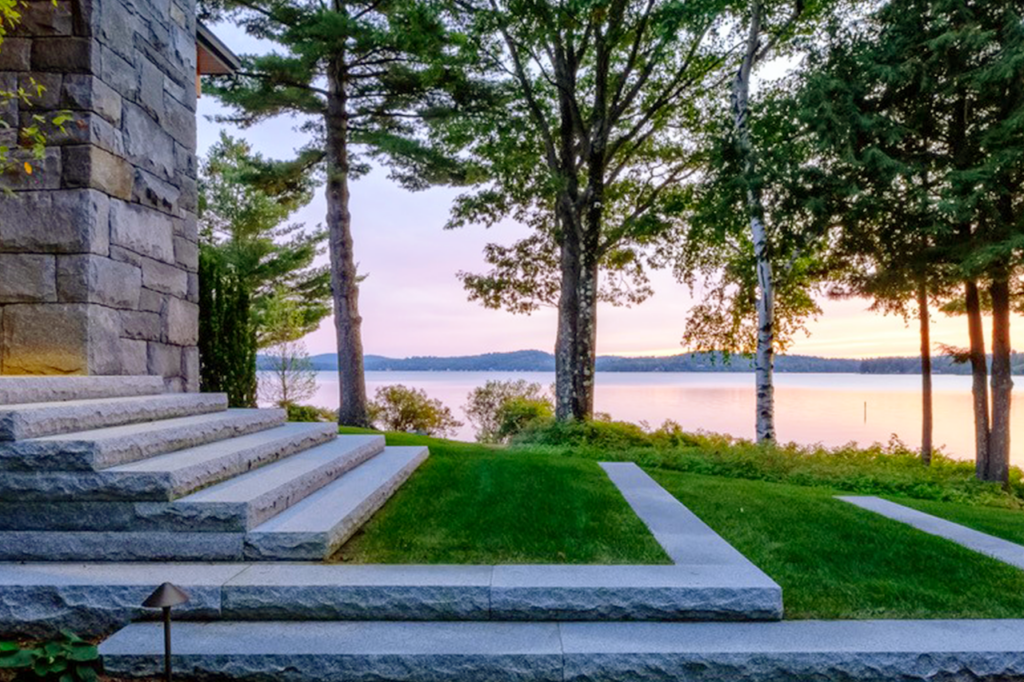
Whether rustic or contemporary, minimal or intricate, all beautiful landscape designs have one thing in common: a well-balanced combination of hardscape and softscape.
Hardscape consists of the solid, heavy, unchanging parts of a landscape, such as stone paths, retaining walls, gravel and patios, while softscape describes the living, botanical elements of a landscape, including plants, soil, shrubs, and flowers Unlike hardscape, softscape is moveable and changes frequently—sometimes as often as several times per season. Your local Swenson Granite Works store can help with any hardscape design by supplying you with the natural stone and granite needed for your project.

Photo credit:Jeff Sinon Photography
In this New Hampshire home, the hardscape includes elements such as Woodbury Gray granite steps, stone patio and walkway, while flowers, shrubs, and grasses make up the softscape. Project by Pellettieri Associates, Inc.
It is critical to balance hardscape and softscape elements when designing an outdoor space. For example, a hardscape-heavy yard can run the risk of appearing commercial, while, in contrast, a landscape with an abundance of softscape can look overgrown and chaotic.
“Hardscape and softscape are the complete opposites of each other, yet both are necessary to make a landscape fully functional,” according to The Spruce. When combined correctly, the two elements complement one another; hardscapes provide structure and form, while softscapes add color and natural beauty.

Photo credit: Jeff Sinon Photography
A New Hampshire home shows a beautiful balance between hardscape and softscape, creating a colorful, yet structured appearance. The steps and walkway are Woodbury Gray granite. Project by Pellettieri Associates, Inc.
Hardscape Design
Hardscape is installed before softscape and serves a functional purpose as well as aesthetic. Structural factors that preserve the property are considered just as important as the materials themselves.
“Hardscaping helps protect the integrity of the land,” said Clients First Landscape Solutions. “With the construction of retaining walls, stone walkways or patios, the loosening and erosion of soil is considerably curbed.”
Drainage is often the most important factor in the design process. “Lack of proper drainage in hardscaping might lead to a number of problems such as flooding, soil erosion, and even collapsing of retaining walls,” warns ARJ Landscape. Landscape professionals will account for proper drainage when planning an outdoor space.

Photo credit: Jeff Sinon Photography
The entrance of a central New Hampshire home features a beautiful hardscape with Woodbury Gray granite thermal top and rock face steps. Project by Pellettieri Associates, Inc.
The fixed natural elements of the outdoor space must also be considered in hardscape design.
Lloyd Hull, Owner of See Level Landscape Design, recommends planning the hardscape around existing trees and factoring their future growth into the design. “If you don’t give a growing tree a wide enough space to grow, then your walkway is going to get picked up,” he explained.
In addition to natural elements of an outdoor space, it is also critical to consider the existing layout and space available, especially when working with a small yard. With the proper design and planning, both hardscape and softscape features can transform a small outdoor area into a beautiful landscape.
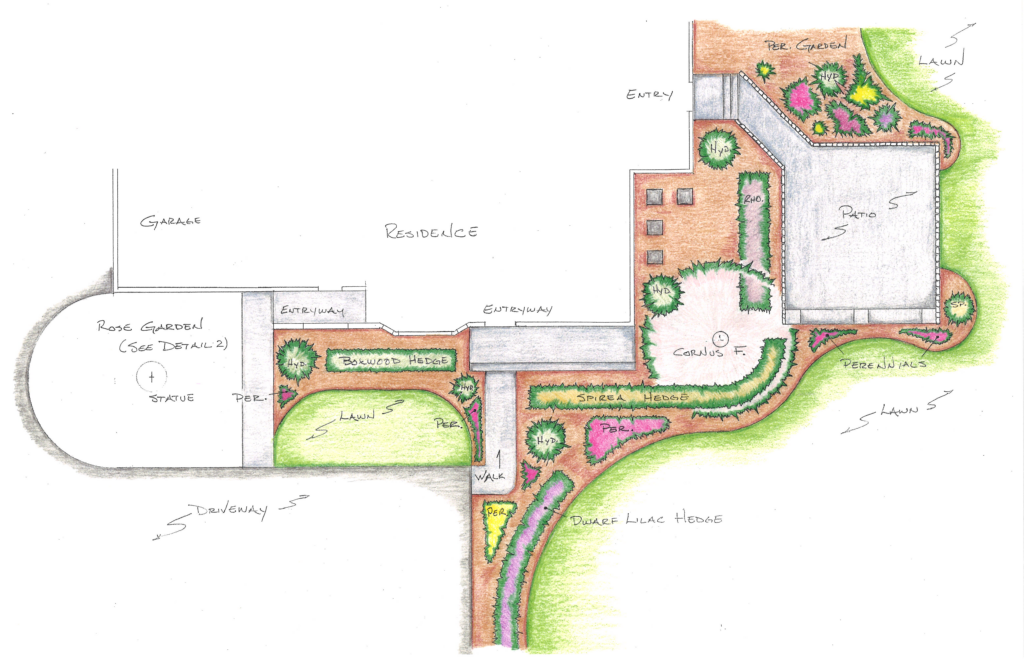
Landscape plan by See Level Landscape Design.
Combining Hardscapes and Softscapes
Hardscapes and softscapes can be either contrasting or complementary, depending on the desired design style, whether modern and structured or informal and natural.
Greg Grigsby, PLA, Senior Landscape Architect and Project Manager of Pellettieri Associates, explained how he and his team combined hardscape and softscape to create a stunning outdoor design for a contemporary home at Lake Sunapee in New Hampshire. The project was designed with Joe Rolfe of Stone Mountain Masonry.
“We came up with a planting scheme that mirrored the contemporary look of the house: clean lines, monolithic groups of plantings, and in areas where it was going to be less formal with native boulders, we went with a more informal planting design,” Grigsby explained.
“A lot of the time the two (hardscape and softscape) speak to each other, so you’re trying to mirror what they do. And other times, depending on what the project is, you may attempt to contrast it,” said Grigsby. “Generally, we try to make sure that the plantings speak to the hardscape and we do that through the arrangement, color, and texture of the plants.”
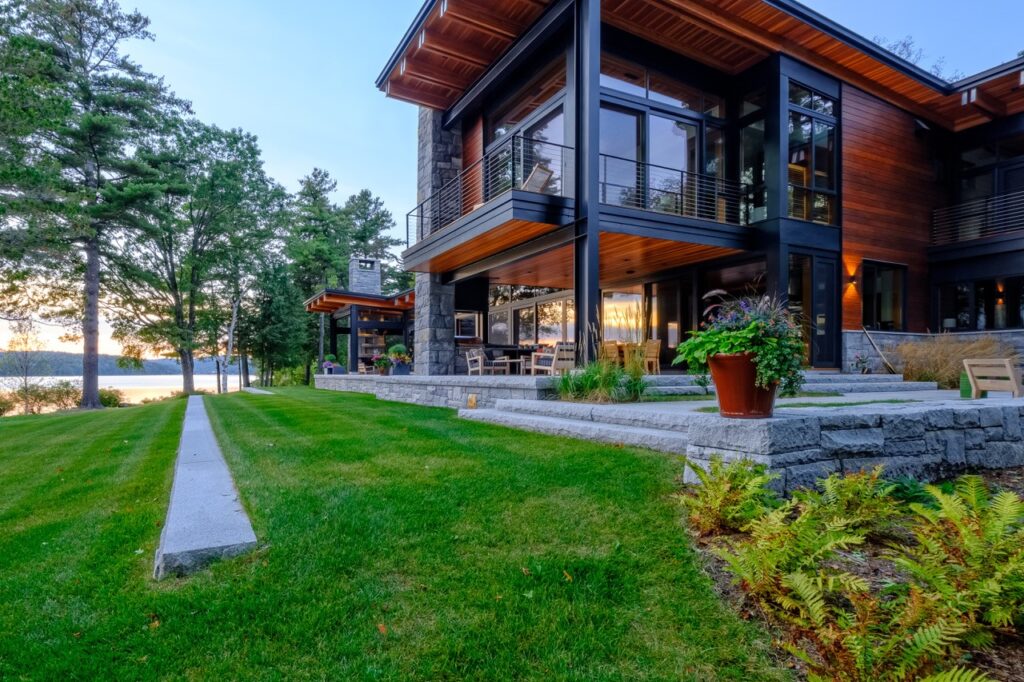
Photo credit: Jeff Sinon Photography
The seasonal planter on the wall of the Lake Sunapee home softens some of the hardscape while adding color and visual interest. The planter and long beam are used to transition the grade, and the ferns soften the steep grade and connect the spaces.
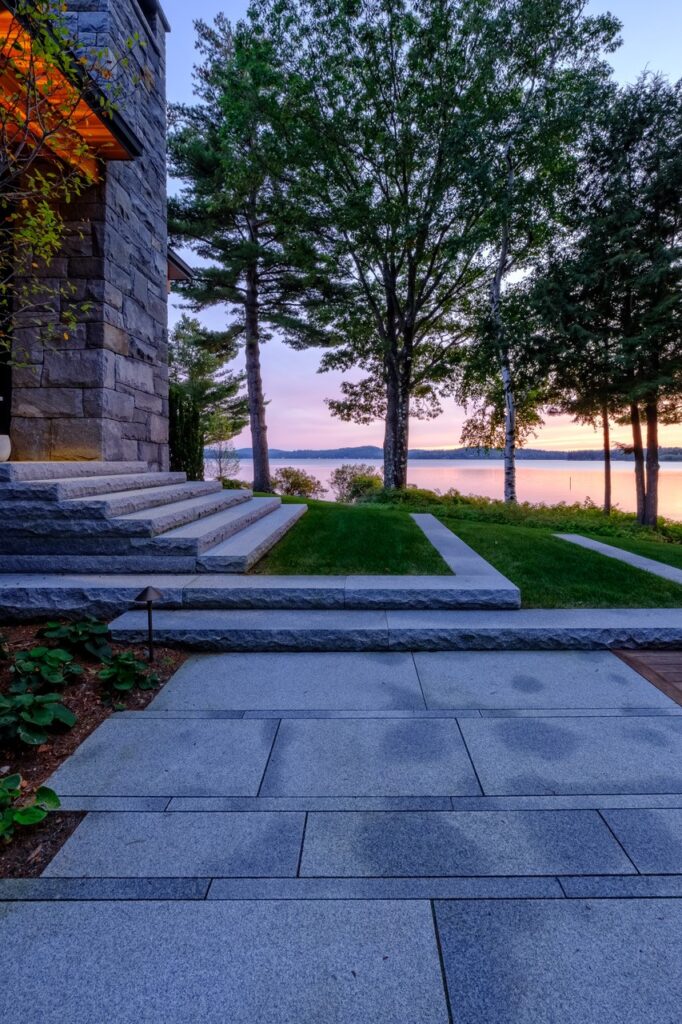
Photo credit: Jeff Sinon Photography
An outdoor space featuring heated Woodbury Gray granite pavers and a two turf landing provides a balance of structure and greenery.
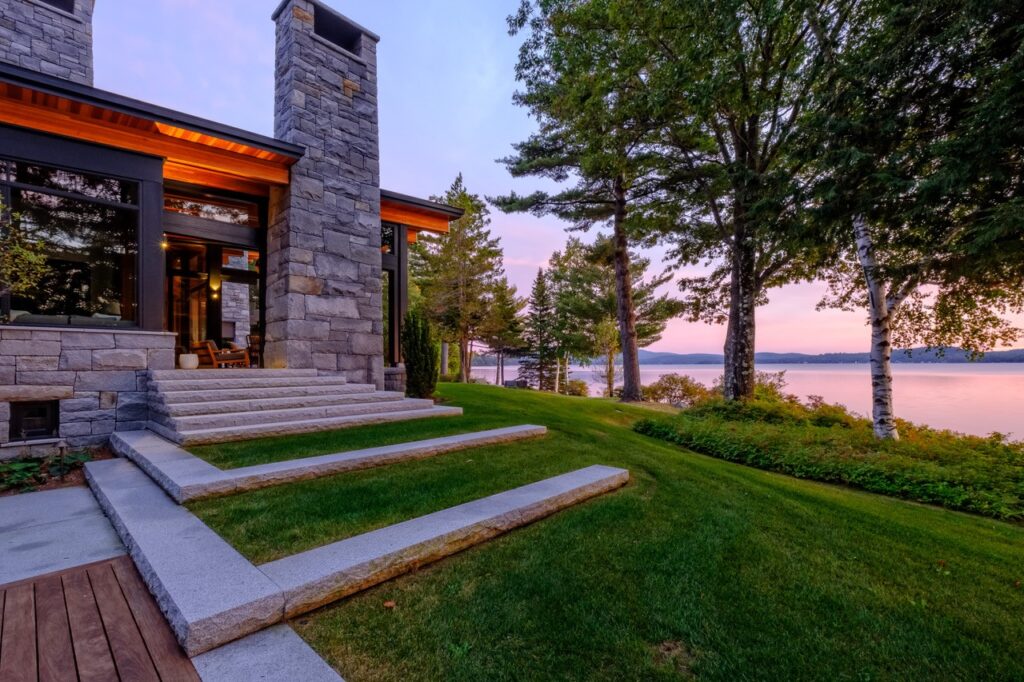
Photo credit: Jeff Sinon Photography
The hardscape is used to provide a smooth transition from house to landscape. A Woodbury Gray granite ledge caps off the top of the veneer below the large glass window. Each piece was custom-made by Swenson to simplify the installation process.
Maintenance
Maintenance required for upkeep should be another key consideration when designing the hardscape and softscape.
“I like to keep things low and simple and very easy on the maintenance level,” said Hull. “When you match the plants to the stone, you also have to match the plants and the stone to the person. If they’re not a gardener or don’t have a lawn service that’s going to be maintaining their property, you have to be careful about what you’re going to plant.”
Choosing between high and low maintenance plants plays a critical role in the future upkeep required. For example, Hull explained that privet hedges, while beautiful, are often difficult for homeowners to maintain because they require pruning every couple of weeks.
A low-maintenance alternative to a privet hedge is a boxwood, which only requires pruning a few times annually and is easy for the average homeowner to care for. Rhododendrons and hydrangeas are also excellent low-maintenance options.
Keeping the future growth of plants in mind is also critical when designing softscapes and hardscapes. “Plant everything as though it’s fully grown,” advised Hull. “Keep scaling in mind, and also the mature size of the plants.” Otherwise, large plants can dwarf hardscape features when they reach maturity.
Color, Texture, and Visual Interest of Softscapes
Plants provide a nearly limitless array of color and texture possibilities for homeowners and landscapers in softscape design.
When combined, different plant varieties can create stunning visual interest. “I love seeing hydrangeas in the proximity of boxwoods or a formalized hedge because it takes two design elements and puts them together in a way that feels really comfortable,” explained Hull.
Hull recommends choosing two or three colors to make a softscape color scheme.

A colorful array of flowers adds texture and softness to a Woodbury Gray granite patio. Pinks, purples, and yellows are complementary colors in this landscape. Project by Great Works Landscape.
Ground Cover, Mulch, and Pebbles
Ground cover elements, from plants to pebbles, provide another way for homeowners to customize outdoor spaces with color and texture.
“We use a lot of hay scented fern sod, it’s a native ground cover. We use it regularly in rustic landscapes, but we also use it successfully in more contemporary landscapes as a huge groundcover mass because it has a really interesting texture,” said Grigsby.
When working with mulch as a ground cover, Hull strongly recommends using bark instead of wood chips near a house to avoid termites. Dyed wood chips can attract fungus, so instead he recommends using peat moss or bark mulch, which is made from pine, hemlock, and cedar bark.

Photo credit: Jeff Sinon Photography
A lush ground cover provides excellent contrast to this contemporary Lake Sunapee home. The entrance features a Woodbury Gray granite paver walkway and Woodbury Gray granite thermal top, rock face steps. Project by Pellettieri Associates, designed with Joe Rolfe of Stone Mountain Masonry.
Pebbles are another ground cover option that work beautifully alongside hardscape elements.
“Around some of the stonework—for example around drip edges—we use a river stone, or Mexican beach pebbles, and they have a really clean, contemporary look for a drip edge,” said Grigsby. In planting beds, a bark mulch is typically used, but a washed stone or imported decorative beach pebble is used to surface other ground areas.

Square stepping stones with Mexican beach pebbles elevate the outside of the Lake Sunapee home. Unlike commonly used black, white, and tan pebbles, these light, rounded stones accentuate the granite hardscape and tie it together with the drip edge on the house. Hay scented fern sod and rhododendrons add a tiered effect to the landscape.
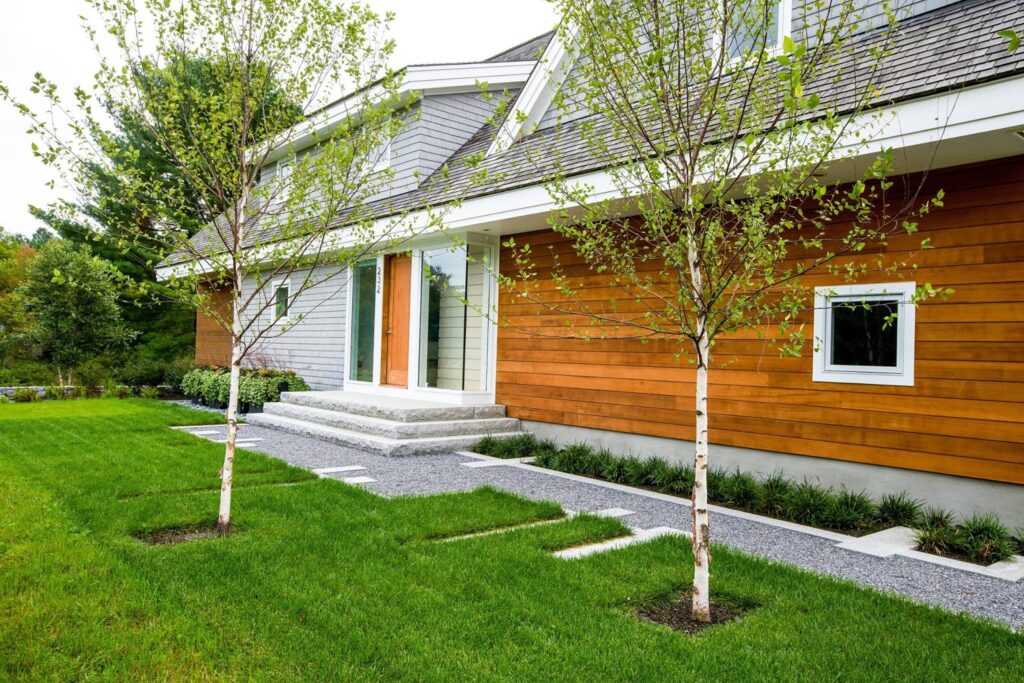
Photography by John McCarthy
Beach pebbles and inlaid Woodbury Gray granite slabs form an artistic walkway outside this minimalist, contemporary home in Andover, MA. Project by Andover Landscape.
Ornamental Grasses
Ornamental grasses can create a range of textures and accentuate different landscape elements, depending on the type selected and the way they are planted.
In one project, Grigsby and his team created a large meadow with ornamental grasses for a homeowner. “It’s rustic and there is a simplicity with that design, whereas on a more contemporary landscape we may take those same grasses and put them in a more formalized planting like in a row—something that reinforces the stonework,” explained Grigsby.
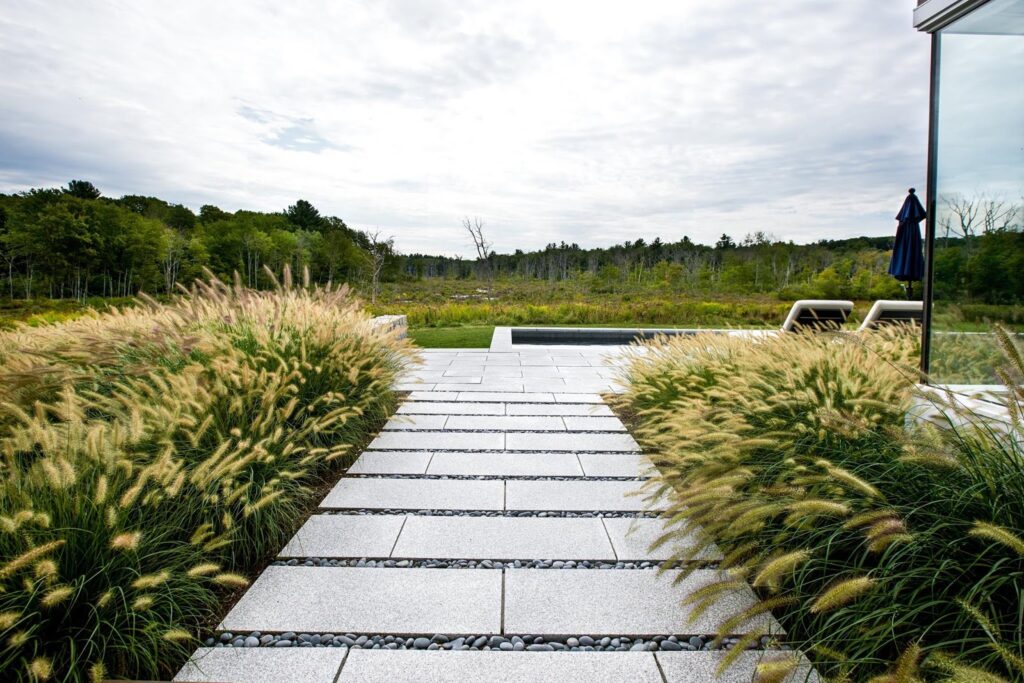
Soft ornamental grasses line the walkway to the pool terrace in this Andover, MA minimalist home, which features Woodbury Gray granite pavers and beach pebble joints. Project by Andover Landscape.
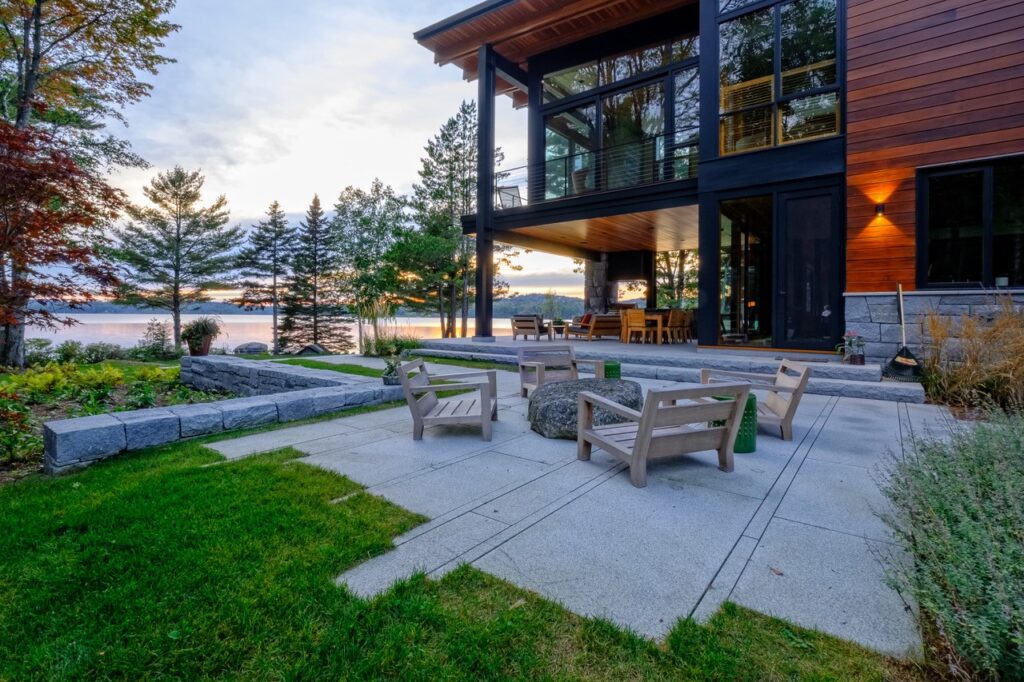
Photo credit: Jeff Sinon Photography
Catmint (Nepata) softens the edges of the Woodbury Gray granite patio of the Lake Sunapee home. Ornamental grasses are shown around the perimeter, and below the wall behind the patio are ferns, red coneflowers and Japanese maple to the left. Project by Pellettieri Associates, designed with Joe Rolfe of Stone Mountain Masonry.
Advice for Homeowners
With the proper guidance from landscape design professionals, anyone can elevate their home with hardscape and softscape features.
“Hire a good landscape architect and talk about what you’d like to do and your objectives,” advised Grigsby. The architect will then work with the homeowner to find the landscape design that works best for them in terms of structure, appearance, and maintenance.
“If you don’t hire a landscape architect, there are certainly other landscape design professionals out there. You can even take a few photos of your property and show them to your local garden center, and they can certainly help with picking the right plant material,” suggested Grigsby.
Ready to transform your yard with an updated landscape? Discover how to use natural stone as part of your hardscape design atyour nearest Swenson location.
